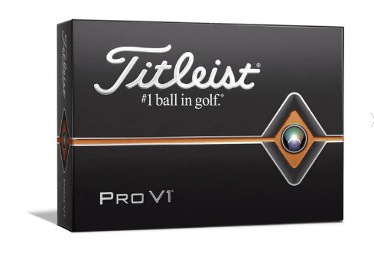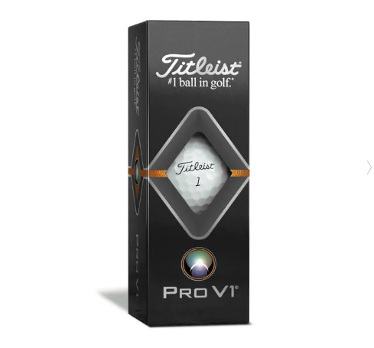
© TITLEIST Golf
Titleist ProV1: The No. 1 Golf Ball for Good Reason
Ball tested: Titleist ProV1
Category: Tour/Advanced/Performance
Specs: Cover – Urethane Elastomer (proprietary material); Construction – Three-piece; Dimples / Pattern – 352 dimples in what Titleist terms a "spherically tiled tetrahedral design"
Compression: Mid Pro V1 (upper 80s compression)
Price as tested (new): MSRP – $62; widely available for less than $50

Ball notes: Titleist is the biggest name in golf balls, and the ProV1 (along with its twin, the ProV1x) is its flagship. By far the most popular golf balls among pro golfers worldwide, the ProV1 models typically outpace their nearest competitor by about 5-to-1 in the weekly tour equipment counts.
Designed for pros and high-level amateurs (single-digit handicaps), the ProV1 is designed to maximize short game control while delivering nearly the same driving length as balls in the "distance" category. It’s also much more durable than its balata-covered predecessors, which were prone to large cuts and scuffs.
This test covers the original ProV1. Titleist markets the ProV1x as the slightly longer of the two models, while the original is a touch softer.
Sound and feel: Ah, that distinctive "smoosh" and "click" that say "Titleist." For decades the company has turned out the best feeling balls in golf, and the ProV1 upholds that tradition. While much firmer than its long-obsolete balata ancestors, the ProV1 sets the softness standard in 2013.
Off the tee: Here’s where modern technology has shrunk the gap between distance and tour balls. In the old days, distance balls (Pinnacle, Top-Flite) were noticeably longer than their high-spin counterparts. Not anymore. Golfers with sufficient swing speeds to compress the ProV1 (around 100 mph or higher) will notice little if any difference in tee shot length between this ball and, say, the Titleist Velocity, which fits into the premium category.
On the other hand, there’s a big difference in workability. Our tester, a highly skilled amateur, had no trouble turning the ProV1 in either direction.
From the fairway / rough: With the irons, it’s all about stopping power. Catch the ProV1 flush and it will check up quickly on the green. Even on low shots with a 5-iron, the ball spins enough to sit sharply after one long hop on a firm green.
Around the green: If short-game control is your top priority, you can’t do better than the ProV1. Crisply struck chips check and spin beautifully, as do bunker shots. Hit the ProV1 a touch thin and you’ll get similar results. The soft feel really boosts greenside confidence.
Bottom line: There’s a reason Titleist maintains a death grip on the "No. 1 ball in golf" title year after year after year: Its products perform. Best of all, the company continually pushes the innovation envelope. The ProV1 is all that it’s cracked up to be, delivering top-notch distance, playability and greenside spin.
We’ll add one caveat, though. Unless you play to a sub-5 handicap, you’ll probably notice little if any difference between this ball and its competitors in the "Tour" category. They’re all very good.
Golf Ball Videos:
- Compression Video
- Spin Video
- Dimples Video
- Golf Ball Brands Video
- Titleist Video
- Understanding Spin Video
Categories Explained:
Value/Recreational/Distance – Designed for mid- to high-handicap golfers with swing speeds below 90 mph; typically feature two-piece construction and firm covers; promote greater distance over high spin rates. Examples: Pinnacle Gold, Slazenger RAW Distance
Premium – Designed for low- to mid-handicap golfers with swing speeds of 90-99 mph; typically feature multi-layer construction and medium-soft covers; happy medium between Value/Recreational and Tour categories for distance and spin qualities. Examples: Titleist NXT Tour, Callaway HEX Diablo
Tour/Advanced/Performance – Designed for low-handicap and professional golfers with swing speeds in excess of 100 mph; typically feature multi-layer construction and soft covers; promote greater spin rates and enhanced feel over distance. Examples: Titleist ProV1, Bridgestone Tour B330

© TITLEIST Golf
Titleist ProV1 (2015 model): All New, Better than Ever
Ball tested: Titleist ProV1 (2015 model)
Category: Tour / Advanced / Performance
Feel: Soft
Tested for golfers with average driving distance of: 196 to 300+ yards (carry + roll)
Specs: Construction – Three-piece; Cover – Thermoset urethane elastomer; Core – “ZG Process Technology”; Dimples / Pattern – 352 in what Titleist terms a “spherically tiled tetrahedral design”
Compression: Mid
Price as tested (new): $62 per dozen, but widely available for $50 or less
Ball notes: Any time Titleist updates its ProV1 models, it’s a big deal. This is the top-selling ball in golf and No. 1 among pros, after all.

Two years after it last tweaked the ProV1 and its sibling, the ProV1x, Titleist gave them a few more nips and tucks for 2015. For the ProV1, the primary change is a new cover formulation designed for a softer feel, increased spin on longer shots and enhanced greenside control. (Here’s our review of the new Titleist ProV1x.)
Keep in mind, the ProV1 has set the industry standard for performance since its introduction in 2000. We had no doubt the new versions would be great golf balls. The question was, would they be noticeably better than their predecessors?
On the clubface: We did, indeed, detect a little softer feel with the 2015 ProV1. It’s certainly not up there with low-compression models like Callaway’s Supersoft, but it’s not supposed to be. While Titleist insists the ProV1 is suitable for all golfers, regardless of ability or clubhead speed, it remains what it’s always been: a ball for better players. If Titleist made it too soft, fast swingers would likely lose distance and accuracy due to excess spin.
Off the tee: We’ve always loved the ProV1’s penetrating yet long-hanging trajectory. And we weren’t disappointed with the 2015’s flight, either. If anything, the new ball spins even less on well-struck drives; it may well fly straighter and roll farther. That was our impression, though it should be noted we did not test the ball with the aid of a launch monitor.
From the fairway / rough: Sweeping draws and 25-yard fades are relics of the balata age. Sure, we miss hitting dramatically shaped shots to tucked pins (or at least the opportunity to try it). But there’s a lot to be said for the modern ball’s unerring flight. On approach shots, the new ProV1 performs like a champ from all distances.
While the ProV1’s default mode is a steady, penetrating carry, a skilled player can easily manipulate trajectory to suit the moment. The ball will even curve a fair amount when called upon. Again, the softer feel is notable off the irons and hybrids.
Around the green: The money shots are the ProV1’s bread and butter. This iteration steps up the spin and stopping power, allowing the graceful chipper to pull off literally any shot imaginable. The bump-and-run, check-and-spin, high flop, hot spinner from sand… If you can dream it, you can do it with this ball. Feel on putts is firm but not harsh, the roll true as ever.
Bottom line: Will another ball ever knock the Titleist ProV1 from its pedestal? Probably. It’ll likely be made by Titleist, though. The company keeps pushing its flagship product to new heights with the smallest revisions. The latest ProV1 not only performs better than ever, it’s more durable than past efforts, too. This ball is built to last.
Golf Ball Videos:
- Compression Video
- Spin Video
- Dimples Video
- Golf Ball Brands Video
- Titleist Video
- Understanding Spin Video
Categories Explained:
Value/Recreational/Distance – Designed for mid- to high-handicap golfers with swing speeds below 90 mph; typically feature two-piece construction and firm covers; promote greater distance over high spin rates. Examples: Pinnacle Gold, Slazenger RAW Distance
Premium – Designed for low- to mid-handicap golfers with swing speeds of 90-99 mph; typically feature multi-layer construction and medium-soft covers; happy medium between Value/Recreational and Tour categories for distance and spin qualities. Examples: Titleist NXT Tour, Callaway HEX Diablo
Tour/Advanced/Performance – Designed for low-handicap and professional golfers with swing speeds in excess of 100 mph; typically feature multi-layer construction and soft covers; promote greater spin rates and enhanced feel over distance. Examples: Titleist ProV1, Bridgestone Tour B330





